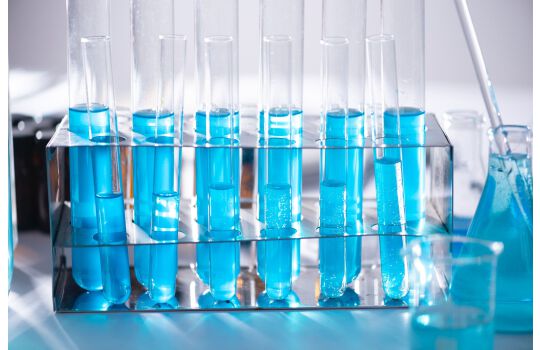Acrylic acid (IUPAC: propenoic acid) is an organic compound with the formula CH2=CHCOOH. It is the simplest unsaturated carboxylic acid, consisting of a vinyl group connected directly to a carboxylic acid terminus. This colorless liquid has a characteristic acrid or tart smell. It is miscible with water, alcohols, ethers, and chloroform. More than a million tons are produced annually.[5]
Contents
1 Production
2 Reactions and uses
3 Substituents
4 Safety
5 See also
6 References
7 External links
Production
Acrylic acid is produced from propylene, which is a byproduct of ethylene and gasoline production:
CH2=CHCH3 + 3⁄2 O2 → CH2=CHCO2H + H2O
Because propane is a significantly cheaper raw material than propylene, considerable research efforts are being undertaken to develop a process based on the one-step selective oxidation of propane to acrylic acid.[6][7][8][9] Carboxylating ethylene to acrylic acid under supercritical carbon dioxide condition is thermodynamically possible when an efficient catalyst is developed.[10]
Because acrylic acid and its esters have long been valued commercially, many other methods have been developed, but most have been abandoned for economic or environmental reasons. An early method was the hydrocarboxylation of acetylene ("Reppe chemistry"):
HCCH + CO + H2O → CH2=CHCO2H
This method requires nickel carbonyl and high pressures of carbon monoxide. It[clarification needed] was once manufactured by the hydrolysis of acrylonitrile, which is derived from propene by ammoxidation, but was abandoned[clarification needed] because the method[which?] cogenerates ammonium derivatives. Other now abandoned precursors to acrylic acid include ethenone and ethylene cyanohydrin.[5]
Dow Chemical Company and its partner OPX Biotechnologies are investigating using fermented sugar to produce 3-hydroxypropionic acid (3HP), an acrylic-acid precursor.[11] The goal is to reduce greenhouse-gas emissions.[12]
Reactions and uses
Acrylic acid undergoes the typical reactions of a carboxylic acid. When reacted with an alcohol, it forms the corresponding ester. The esters and salts of acrylic acid are collectively known as acrylates (or propenoates). The most common alkyl esters of acrylic acid are methyl, butyl, ethyl, and 2-ethylhexyl acrylate.
Acrylic acid and its esters readily combine with themselves (to form polyacrylic acid) or other monomers (e.g. acrylamides, acrylonitrile, vinyl compounds, styrene, and butadiene) by reacting at their double bond, forming homopolymers or copolymers, which are used in the manufacture of various plastics, coatings, adhesives, elastomers, as well as floor polishes and paints.
Acrylic acid is a compound, which is used of many industries like the diaper industry, the water treatment industry or the textiles industry. On a worldwide scale the consumption rate of acrylic acid is projected to reach more than an estimated 8,000 kilo tons, by 2020. This increase is expected to occur as a result of using this product in new applications, including personal care products, detergents and products that are used for adult incontinence.[13]
Substituents
As a substituent acrylic acid can be found as an acyl group or a carboxyalkyl group, depending on the removal of the group from the molecule. More specifically, these are:
The acryloyl group, with the removal of the −OH from carbon-1.
The 2-carboxyethenyl group, with the removal of a −H from carbon-3. This substituent group is found in chlorophyll.
Safety
Acrylic acid is severely irritating and corrosive to the skin and the respiratory tract. Eye contact can result in severe and irreversible injury. Low exposure will cause minimal or no health effects, while high exposure could result in pulmonary edema. The LD50 is 340 mg/kg (rat, oral).


